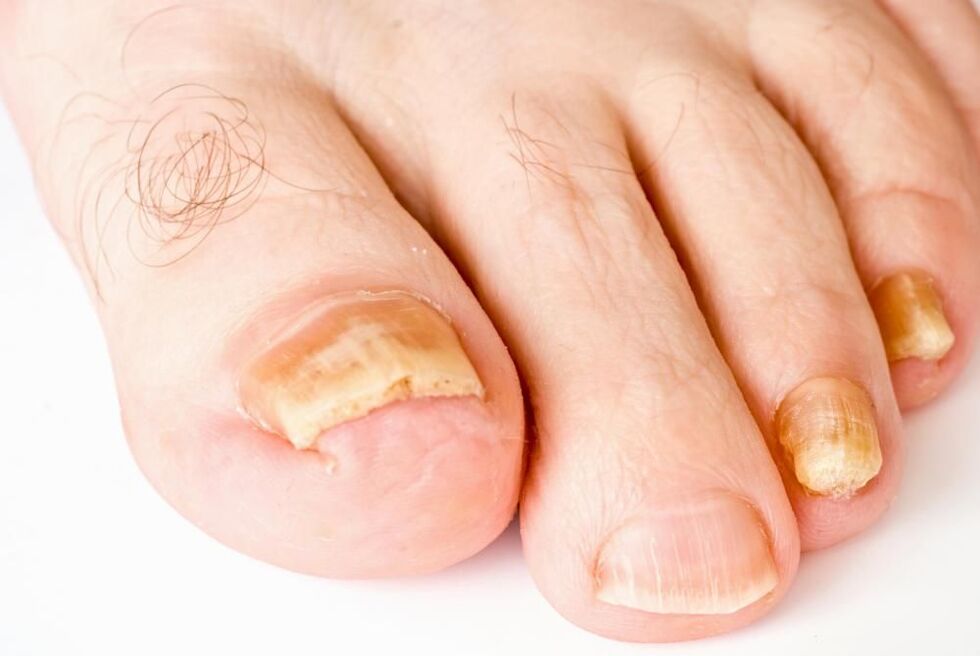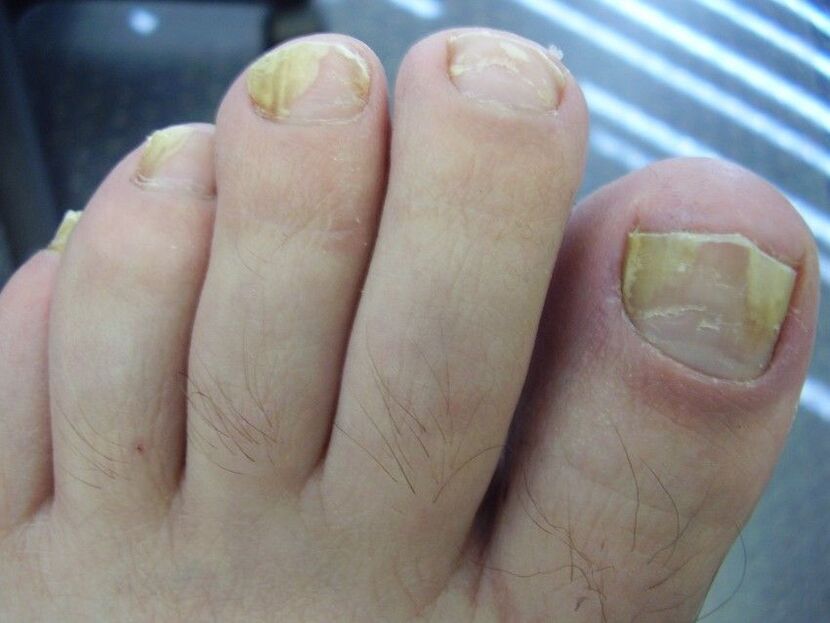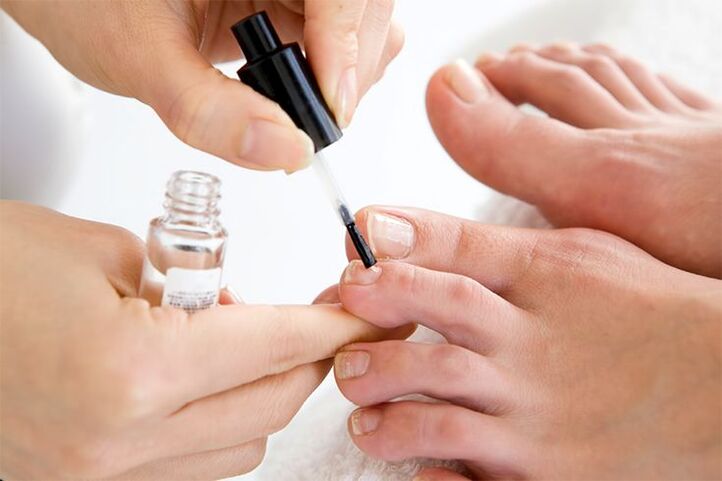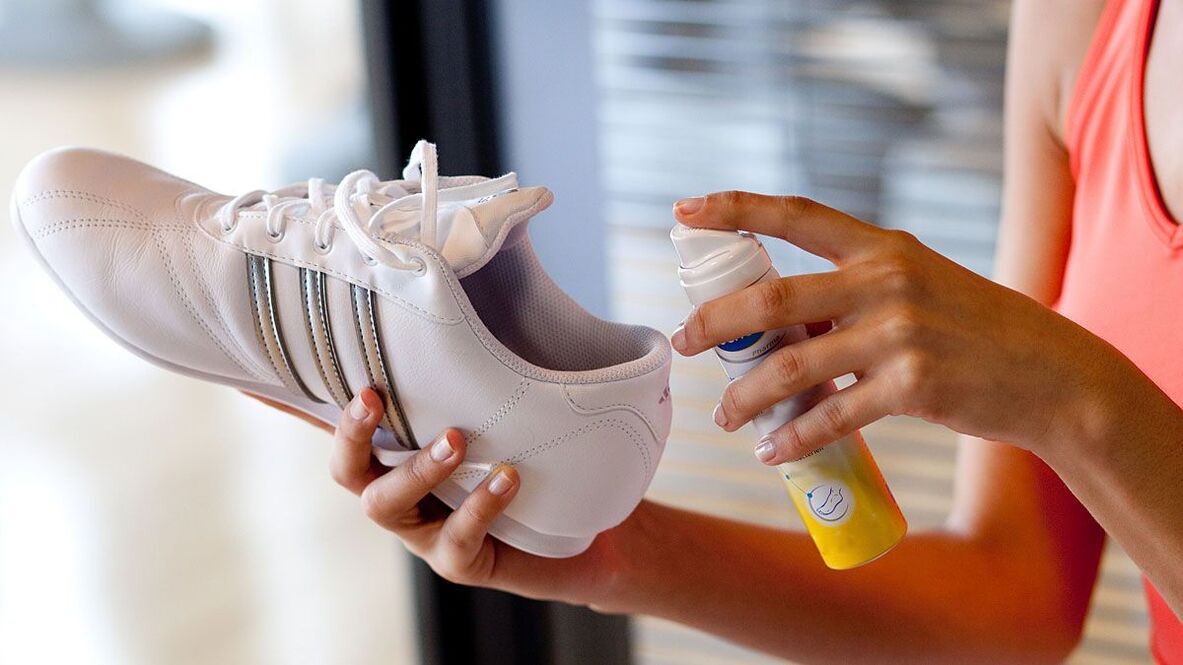Hello dear reader. Nail fungus is one of the most common forms of fungal damage to the body. The illness is unpleasant and not easy to recover from. The disease cannot start, because it is not a cosmetic problem, but a serious pathology. But not everyone knows which method is the right one. It should be immediately noted that self-medication is not the best option in this case. But information about what the disease is and how to get rid of nail fungus quickly will not be superfluous to anyone.
What Causes Fungal Nail Infections
Nail fungus, or medically known as onychomycosis, is a disease in which parasitic fungal microorganisms cause damage to the nail plate and adjacent areas. This is one of the subspecies of fungal disease. Onychomycosis is the most common if we consider all diseases that can only occur on the feet.
You can get infected in public places with excessive humidity. This includes bathrooms, steam rooms, swimming pools and beaches.
Wooden objects (benches, sunbeds, etc. ) are widely used here. Due to the porous nature of the wood, the fungus in there is very difficult to kill.

In addition, doctors distinguish several risk groups. For someone with one of these, the likelihood of infection increases dramatically.
- cancer patients receiving chemotherapy;
- After a course of treatment with antibiotics or steroids;
It is not always possible to get rid of the disease quickly. The cure rate depends on the species of parasite causing it, the stage of development of the disease, the size of the lesion, the presence of complications and concomitant diseases, and the general condition of the body.
Onychomycosis Symptoms
The damage of parasitic fungi to nails cannot be ignored. Symptom changes in the nail plate are very obvious and can be attributed to the following points.
- Loss of natural luster, transparency.
- Colors are changing. It can be yellowish, brown, white, blue, green, gray.
- Surface roughness appears.
- Streaks, spots, and thickened areas are clearly identifiable.
- Stratification was observed.
- The nail bed has fallen off.
- Different areas were painted and chipped.
- The surrounding tissue may become red, swollen, and itchy.
- Pain.
- Feet smell bad.

Still, self-diagnosis can be difficult. In the early stages of development, the symptoms of onychomycosis are similar to those of some other lesions: trauma in the area of the nail.
How to Get Rid of Toenail Fungus Fast Using Folk Remedies and Medications
You should be realistic and understand that fungal infections of the nails and nail area are not treated in a week. According to doctors, the healing period can last anywhere from 6-8 weeks to 6 months, sometimes even 8-12 months.
It depends on many factors, as well as the growth activity of the nail. In the hands, the process goes on much faster than in the legs, so the healing here comes earlier.
The best and fastest positive results can be obtained if you follow the recommendations below.
- A variety of therapeutic measures are used in the complex. Do not rely on the effectiveness of any one miracle cure. Combining pharmaceutical preparations and traditional pharmaceutical formulas ingeniously.
- Treatment should be aggressive, but gentle—aggressive medications typically used for therapeutic purposes should not affect healthy areas of the body located near the affected area.
- Strict adherence to hygienic requirements, so that the fungus does not spread, but also to avoid reinfection soon after the cure. And it's very likely.
- Note that the affected extremity is dry. Remember that humidity and heat are ideal conditions for the fungus to thrive actively.
- Eliminate all causes of the appearance of onychomycosis and eliminate them.
- Every day, clip the edges of growing nails affected by the disease as gently as possible. If possible, perform a laser irradiation procedure, which very effectively suppresses the pathological activity of pathogens.
potion
Drugs acting on pathogens are usually divided into three subgroups according to the active ingredient. Each of them has topical ointments and tablets with general effects on the entire body in their arsenal.

It should be borne in mind that the latter has many side effects. Therefore, you should not prescribe your own medication. To minimize the risk, you will need to be tested to identify the species of fungus causing the disease and to be given "targeted" medicines.
Subgroups of Antifungals
- Azole preparations. They are based on triazoles or imidazoles, and their derivatives. Depending on the concentration, they exhibit a fungicidal or fungicidal effect. They are effective against mold and yeast-like fungi.
- Allylamine agent. The active ingredient may be terbinafine, naftifine, butenafine. They prevent the growth of fungi and are also anti-inflammatory.
- other medicines. They act on the basis of flucytosine, morpholine, griseofulvin, chloronitrophenol additives. They are characterized by narrow activity against certain types of fungal pathogens.
external means
In the early stages of onychomycosis development, people should only resort to ointments. The administration of antifungals in tablets was introduced only when they proved ineffective.
Difference between cream and ointment:
- have a direct effect on the lesion;
- Fewer contraindications;
- Adverse reactions were limited.
If you catch the disease early in development, you can deal with it within a month.
Most Popular Antifungal Creams and Creams
- Ointment zinc. Allows you to reduce inflammation, dry the affected area, relieve itching, and play an adsorption role.
- Clotrimazole. broad-spectrum substances. Duration of use - from 2 weeks to six months. It also has antiseptic properties. May cause skin dryness, burning, and irritated skin manifestations. Pregnant women and breastfeeding mothers and children under the age of three are contraindicated.
- Naftifine. Fights inflammation and has antibacterial properties. This agent tends to accumulate on treated surfaces. Use this ointment no more than twice a day. The tool is not used during pregnancy and lactation.

tablet use
For a systemic effect on the entire body, doctors prescribe oral tablets. Broad-spectrum drugs were prescribed.
- Substances fluconazole, mefluconazole. Just taking it once a day is enough. The agent was well tolerated. In rare cases, intestinal disorders and body rashes may occur. The course of treatment can be 1-4 weeks.
- Substances orungal, sporanox. Can be used for pulse therapy. The drug is not indicated for renal failure, pregnancy, hypersensitivity to the action of the drug. May cause allergic reaction, dizziness, hypokalemia, abdominal pain.
All medications for hand or toe nail fungus should be taken only after consulting your doctor.
How To Treat Toenail Fungus At Home With Folk Remedies
First, you should strictly follow all medical advice and not end treatment by skipping doses or interrupting a course of treatment after a particularly bothersome symptom has resolved.
Additionally, you will need:
- frequent use of local baths;
- A special varnish is used to stop the spread of the fungus and has healing properties;
- daily removal of the protrusion of the growing nail affected by the disease;
- softening of the nail plate using a special method to remove it;
- steaming hands or feet before applying topicals;
- Take steps to prevent household infection.
Special paint
Lacquer has many advantages. The active ingredient penetrates deep into the affected nail, but at the same time hardens and does not leave marks on clothes, sheets, shoes.
The sclerotic layer reliably blocks the oxygen supply of the pathogens and thus blocks their activity. But varnish products are only effective for the initial stage of onychomycosis.

Before applying the varnish, you should use a local warm bath. Soaked boards affected by the fungus are maximally cut, processed with a file or other abrasive device. dry surface
It is also recommended to use varnish to cover healthy nails. The procedure is repeated every night for a long period of time - anywhere from a few months to six months.
surgeon's help
Parts and entire boards can be removed. But this does not guarantee complete freedom from the disease. The possibility of further spread of the fungal infection is very high.
After surgery, the finger will heal for a long time. In addition, suppuration may occur. Newly grown nails may become deformed. A preferred alternative to this method is laser therapy.
After surgical removal of the damaged nail, special emphasis is placed on the drug treatment of the fungus. In some cases, especially severe ones, the growth area can be removed, after which the finger will remain "naked" - the nail will no longer be able to grow there.
traditional medicine
Alternative methods are slower than medical methods but have fewer side effects. They are only effective in the treatment of the early stages of disease development.
Later, folk remedies were exclusively used in combination with pharmaceutical preparations as an auxiliary measure.
For the treatment of nail fungus, these drugs are used.
- garlic. Apply garlic porridge on sore nails. Fix the bandage on top. Repeat the procedure every night. You can also use squeezed garlic juice mixed with an equal amount of alcohol. Treat your nails with the resulting balm twice a day.
- Bitter. Acetic acid acidifies the environment, thereby inactivating pathogens. The tool lubricates damaged nails daily. You can use a vinegar compress. To do this, dip a cotton wool piece in vinegar and fix it on the desired finger on the affected area. The compress lasts overnight and removes in the morning.
- peroxide. Apply directly to nails or with a cotton swab, like vinegar and other similar products. Peroxides are used as preservatives.
- Alcohol solution of iodine. They coat the nail plate, including healthy ones, 1-2 times a day. Also, iodine supplements are suitable for any bath. To do this, just add a few drops of the product.
- Propolis tincture. It can be used in washes or infused into topical baths for hands or feet. The compresses are left on the nails overnight. You can prepare an ointment which is a mixture of propolis and butter. The composition is superimposed on gauze and placed on the desired area. Leave the agent on for 10 hours.
- Burning therapy from vegetables. For the treatment of onychomycosis, onions or horseradish are suitable. They have antibacterial activity. Herbal products are used in the form of porridge. You can also make an ointment by mixing liquid pomace with butter or rendered chicken fat.
- Essential extracts. These funds have an anti-inflammatory, antibacterial, regenerative effect. To prepare a topical bath or as part of a compress blend, fir oil and some other oils can be used.

Essential extracts are mixed with petroleum jelly in a 1: 1 ratio. It should be rubbed onto the damaged nail plate. In this case, the drug works better if the nails are steamed first.
What are Fungal Nail Infections?
fungal nail infectionis also calledDermatophyte onychomycosis. The initial fungus affecting the skin of the feet is a common infection of the skin of the feet, especially between the toes. On the skin of the feet, primitive fungi live in the keratin that makes up the outer layer of the skin. When the fungus spreads to the cuticle of the nail,fungal nail infection.
What causes fungal infections?
fungusDiffusion from the feet (called"dermatophytes"), causing most fungal nail infections. Less commonly, nail infections are caused by other types of fungus, usually yeast (for example,Candida) andmold.
These fungi tend to attack already damaged nails because the fungus has easier access. Fungal infections of the toenails are very common (up to 1 in 4 people may be affected at any given time), and less common are toenail fungus. Both types are most common in older adults, people with weakened immune systems, and people with diabetes and poor peripheral circulation. A warm, humid environment helps the fungus grow and cause infection. Wearing tight shoes or using the shower, bathroom, or changing room increases the risk of a fungal infection.
Are they genetic?
Absolutely not. However, in some extremely rare cases, there are genetic risk factors and other family members may also be susceptible.
What are the symptoms of a fungal nail infection?
Initially, there are usually no symptoms. Afterwards, the nail may thicken and become painful when pressed against the inside of the shoe. Then they are very difficult to prune. Seeing infected nails, especially fingernails, can be embarrassing. Affected nails can ruin socks and tights, as well as chafe adjacent skin. The nearby skin may also have a fungal infection; it may itch, crack, blister, or turn white, especially between the toes.
What do fungal nail infections look like?
OnychomycosisUsually starts at its free edge and spreads along the sides of the nail to the base of the cuticle. Eventually, the entire nail may be affected. The infected area turns white or yellowish, thickens and flakes. Less commonly, there may be white inclusions on the surface of the nail. The nails on the big toe and little finger are most susceptible to damage from fungal infections. Sometimes, especially those who often do wet jobs, such as housewives or cleaners, the skin around the nails can become red and swollen. This is called a paronychia and can allow infection to easily enter the nail.
How are fungal nail infections diagnosed?
fungal nail infectionUsually diagnosed clinically. Your doctor may remove a piece of the infected nail and send it to a lab to see if the fungus can be seen under a microscope or cultured. Sometimes it may be necessary to resample.
Many nail problems can only look likefungal infection, - For example, psoriasis changes after a bacterial infection or an old injury, but antifungal pills don't help. Proper treatment may depend on knowing which fungus is causing the problem; results may take several weeks.
Can Fungal Nail Infections Be Cured?
Yes. However, in order to succeedFungal Nail Infection TreatmentLong-term treatment is required, which may take up to a year. Nails are easier to handle.fungal nail infectionRecurrences are common, especially on the toes.
How are fungal nail infections treated?
fungal nail infectionDon't worry about it yourself, not all of them need treatment. Some people with toenail infections have nothing to worry about at all. In this case, it is sometimes possible to leave them alone (although patients must be careful not to spread the infection to other parts of the body and to the nails, as well as to other people).
On the other hand, ifinfected nailsCause embarrassment or discomfort, and they usually get treated. It is important to treat people whose infections can cause serious health problems, such as diabetes or a weakened immune system, to prevent potentially serious health problems.
The goal of treatment is to get rid of the fungus: the nail then usually returns to normal. However, if the nail was damaged before it became infected, it will be more difficult to clean and may return to its original state.nail infectionBacteria caused by mold and yeast are very resistant to treatment.
Treatment options include:
Treatment applied to the nails (topical procedure)
Treatments applied to the nails are not as effective as oral treatments. They are most effective if the infection is in the early stages. The most commonly used methods are amorolfine-based nail polish, ciclopirox, and thioconazole solutions.
They may not be able to clean the deeper part of the infected nail on their own, but regular nail clippers or sanding to remove the damaged part of the nail can help. Oral medications are used in combination with antifungal agents to increase the chance of cure. They may take 4-12 months to use before you notice results.
forfingernail infectionThe course of treatment is shorter. The cure rate with topical therapy alone is about 15-30%. Topical treatments are safe. Redness and irritation may occur.
Before starting the drug, the doctor must send part of the nail to a laboratory to check for a confirmed fungal infection.
Substances that may be used to treat fungal nail infections include:
- Griseofulvin has been used for many years and is the only one of three drugs approved for use in children. It is only fully absorbed through high-fat foods such as milk and dairy products, and usually requires a longer course of treatment (6 to 9 months for fingernails and up to 18 months for toenails). However, only about three-quarters of infected nails and one-third of infected toenails were removed. It may also recur frequently.
- Substances such as terbinafine and itraconazole are now largely removed from griseofulvin. They work better and faster, although only about 50 percent of nail infections heal. Terbinafine should be considered first-line treatment for dermatophytes, ie fungi that affect the feet. Take daily for 6 weeks for fingernail infections and 12-16 weeks for foot infections.
- The substance itraconazole is effective in the treatment of dermatophytes; it is also useful in the treatment of other fungi such as yeast. It is usually taken in installments - one week per month - as it gets absorbed into the nail cuticle and continues to work for several weeks. Two sessions per week for 21 days are usually sufficient for nail infections and three sessions for toe infections.
- Fluconazole substances may be effective against Candida fungal infections. It is not currently licensed for use in fungal nail infections. It does not appear to be as effective as itraconazole and terbinafine, but is still an alternative for those who are intolerant of these two drugs.
- other procedures
Lasers and photodynamic therapy may help, but are not as effective as the topical and systemic treatments listed above.
Herbal products are also promoted for use inFungal Nail Infection Treatment, but there is no conclusive evidence that it is safer or more effective than standard treatment.
Are there any side effects from the treatment?
Oral treatments are more likely to cause side effects than topical treatments.
Terbinafine can sometimes cause a potentially very serious allergic reaction, may slightly worsen skin conditions, and can sometimes affect taste buds.
Itraconazole is not for use in people who are already taking certain medicines. Your doctor will tell you about this. Both terbinafine and itraconazole affect the liver, and your doctor may do blood tests before and during treatment to check for this.
Although griseofulvin is the only drug approved for use in children, many dermatologists prefer terbinafine because it is more effective.
How will I know if treatment is working?
New nails will grow slowly from the base, and it may take 6 months to a year after treatment ends for the nails to return to normal. Foot infections clear up faster and more completely than toenails; feet can take up to 18 months to fully heal.
surgical nail removal
Sometimes surgeons can remove very thick nails that don't respond to medication under local anesthesia, but this is rarely done because the degree of success of the treatment does not justify surgery.
Take care of yourself
- Keep nails short, dry and clean. Use one pair of scissors to cut the infected nail and the other to cut the nail.
- Don't just treat your nails; treat the skin on your feet with an antifungal cream.
- Avoid trimming cuticles yourself or by your manicurist, as this increases the risk of nail damage and infection.
For fungal infections on the toes:
- Wear comfortable, well-fitting shoes, not high heels or tight socks.
- Keep feet dry, wear cotton socks and change them daily, and wear breathable shoes. Regular washing in hot water will remove most soiled socks, but an antifungal spray before washing is more effective. Other clothing generally cannot be contaminated.
- Maintain foot hygiene, including treating any infections.
- Please wear clean shower shoes when using shared showers.
- Pay special attention to the hygiene of the affected foot.
- If thickened toenails make walking uncomfortable, consider seeking help from a podiatrist.
Precaution
The risk of reinfection with the fungus after getting rid of the disease is very high. Therefore, you need to clearly follow simple rules:
- Pay attention to foot hygiene;
- Get rid of shoes, towels and socks used during treatment;
- Avoid sharing such items with other family members;
- Avoid excessively wet feet and use talcum powder;
- Treat the inner surface of the shoe with an antiseptic.

Don't forget that all medications for nail fungus should be taken after consulting a doctor.
















